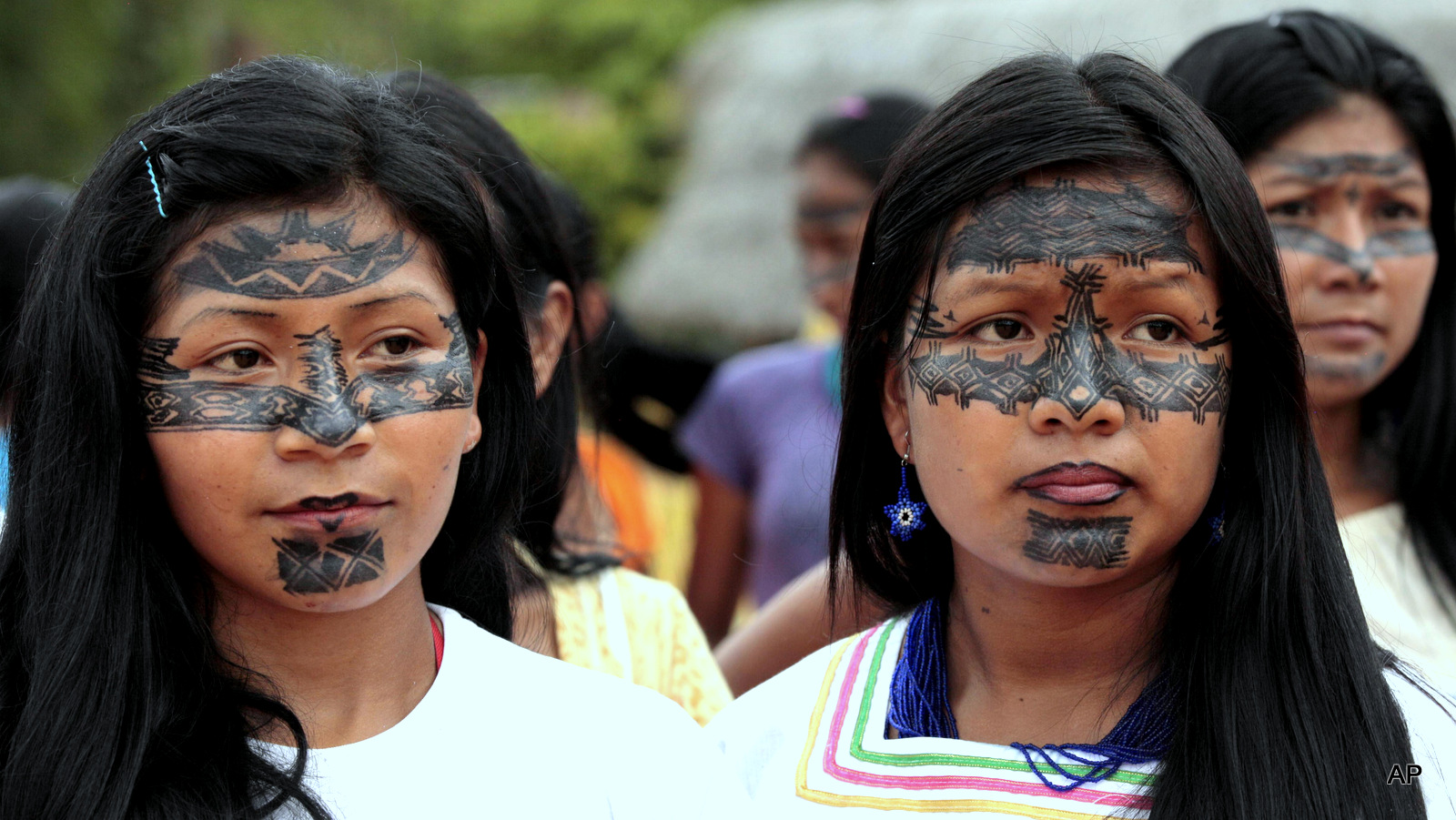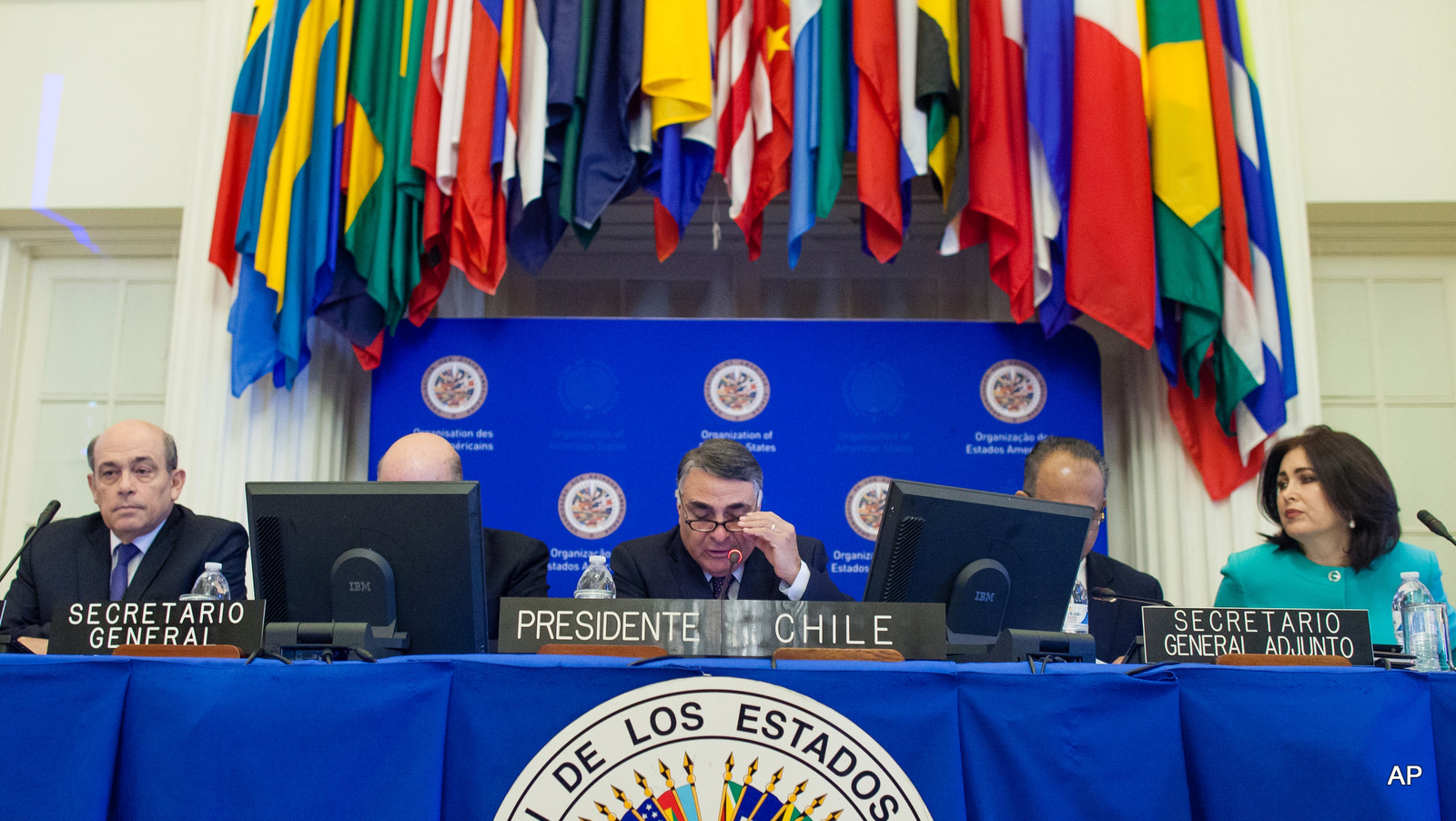After 18 years of negotiations, the Organization of American States is gathering momentum on a declaration aimed specifically at protecting the rights of indigenous peoples throughout the Americas — even without the participation of the U.S. and Canada.
 Sarayaku women attend a ceremony where the Ecuadorian Government offered a public apology that came as part of a ruling by the Inter-American Human Rights Court which found that the government allowed for oil exploration in Sarayaku lands without their consent. Indigenous people will have access to the courts as part of a recent historical declaration protecting the rights of Indigenous peoples through-out the Americas, with the exception of the U.S. and Canada.
Sarayaku women attend a ceremony where the Ecuadorian Government offered a public apology that came as part of a ruling by the Inter-American Human Rights Court which found that the government allowed for oil exploration in Sarayaku lands without their consent. Indigenous people will have access to the courts as part of a recent historical declaration protecting the rights of Indigenous peoples through-out the Americas, with the exception of the U.S. and Canada.
WASHINGTON — Negotiations held over the past 18 years toward resolving historic issues of land dispossession and conflicts over natural resources with indigenous peoples of the Americas are finally expected to reach consensus by May.
“We were told there are some states very interested in getting the declaration done so we can move to another stage in the Organization of American States (OAS) and be able to enforce the rights recognized,” said Leonardo A. Crippa, a senior attorney for the Indian Law Resource Center in Washington. “It’s aiming to be completed by May so the text can be submitted for approval to the General Assembly of the OAS, which is meeting in D.C. in June.”
Crippa comes from the Kolla indigenous community in Argentina, who reside mostly in the high-altitude forests, or yungas, of the Amazon rainforest. The Kollas and indigenous groups like them throughout the Americas have long been affected by threats to their ways of life and land. Building off of the U.N. Declaration on the Rights of Indigenous Peoples (UNDRIP), the OAS has been working on a draft declaration that specifically protects the rights of indigenous peoples in the Western Hemisphere.
This process began in 1989, when the OAS General Assembly approved a resolution to ask the Inter-American Commission of Human Rights (IACHR) to prepare a declaration on the rights of indigenous people of North America, South America, Central America and the Caribbean. The IACHR submitted the first Draft American Declaration on the Rights of Indigenous Peoples in 1997.
Also that year, the Indian Law Resource Center and other indigenous rights groups such as the Native American Rights Fund in Colorado petitioned the OAS to create a working group to discuss issues with member states and work toward reaching consensus on resolutions.
Meetings were put on hold in 2012 because of a lack of funds among OAS member states and a lack of political will. But they resumed in February and March, with three days of negotiations held each month, and more meetings are scheduled for this month and next. The process is being fast-tracked by Diego Pary, Bolivia’s ambassador to the OAS.
Four indigenous representatives will participate in the declaration’s presentation to the OAS General Assembly in June — one each from South America, Central America, the Caribbean and North America.
“We are doing our best to advise indigenous representatives, have discussions with the OAS, and compose language that is more defined than the U.N. Declaration [on the Rights of Indigenous Peoples] to reflect regional issues,” Crippa said.
Yet, as Crippa notes, the United States and Canada, among other OAS states, have not accepted the jurisdiction of the Inter-American Court on Human Rights and continue to refuse to sign onto the draft declaration.
A statement released by the U.S. delegation to the negotiations in March states:
“The United States remains committed to addressing the urgent issues of indigenous peoples in the hemisphere, including combating societal discrimination against indigenous peoples, increasing indigenous participation in national political processes, addressing lack of infrastructure and poor living conditions in indigenous areas, and collaborating on issues of land rights and self governance.”
It also notes that the U.S. “continues to believe the OAS can be mobilized to make a practical difference in the lives of indigenous peoples,” but reiterates that it refuses to sign the declaration.
The United States’ specific reservations are not clear, and MintPress’ calls to the office of Michael Fitzpatrick, deputy permanent representative at the U.S. mission to the OAS, have gone unreturned.
“The important thing … is that we have access to inter-American courts”
When efforts to resolve issues have failed to find remedy in their own country, the IACHR can be appealed to. All 35 member states of the OAS are under the jurisdiction of the IACHR, headquartered in Washington. No country can be a part of the OAS process without ratifying the OAS Charter.
“All 35 member countries have signed the Declaration on the Rights and Duties of Man of 1948,” said Maria Isabel Rivera, director of Press and Publications for the IACHR. “This means the Commission analyzes all cases and petitions and monitors human rights situations in those countries under the light of the rights recognized in the Declaration.”
Countries that have not ratified the convention include the Bahamas, Belize, Canada, Cuba, Guyana, St Kitts and Nevis, St. Lucia, St. Vincent and the Grenadines, and the U.S. Thus, cases originating in these countries cannot be brought to the Inter-American Court of Human Rights, but they can be brought to IACHR in a petition of injustice.
“The important thing about the American Declaration is that we have access to inter-American courts,” said Armstrong Wiggins, a Miskito Indian from Karata, Nicaragua, and director of the Indian Law Resource Center.
UNDRIP was adopted by the U.N. General Assembly in New York on Sept. 13, 2007 to encourage countries to work alongside them on global issues. It was agreed in November of that year that UNDRIP would be used as the foundation for an OAS declaration and all the terms of the OAS document would be consistent with or even more favorable to UNDRIP.
UNDRIP contains 23 preambular clauses and 46 articles defining the rights of self-determination of the world’s 370 million indigenous peoples, including issues of culture, health, education and environment. Article 31, for example, emphasizes that indigenous peoples will be able to protect their cultural heritage and other aspects of their cultures and traditions.
Wiggins says states which “negotiated with us at the U.N. Declaration are the same as the OAS,” and the OAS declaration focuses on issues pertinent to the region, like expanded labor funds and the health, education and safety needs of children.
Protecting voluntary isolation, preserving traditions
 Chilean Vice-Minister of Foreign Affairs Edgardo Riveros speaks at the beginning of The Forty-Ninth Special Session of the General Assembly of the Organization of American States in the Hall of the Americas of the headquarters of the Organization of American States in Washington, Wednesday, March 18, 2015.
Chilean Vice-Minister of Foreign Affairs Edgardo Riveros speaks at the beginning of The Forty-Ninth Special Session of the General Assembly of the Organization of American States in the Hall of the Americas of the headquarters of the Organization of American States in Washington, Wednesday, March 18, 2015.
“There are regional particulates that are unique and not defined in the U.N. Declaration [UNDRIP],” Crippa said.
He used the example of people in the Americas living in voluntary isolation, emphasizing, “We need to protect these peoples from internal armed conflicts, such as in Colombia, where they’re caught in the middle of military, paramilitary and guerrilla forces. It’s a situation of a government of a country trying to control land of indigenous peoples without respect to their rights.”
Indigenous peoples in voluntary isolation are groups or individuals who remain untouched by non-indigenous populations. They do not maintain contact with non-indigenous populations, may reject any type of contact, or may have chosen to return to their traditional culture and break relations with non-native societies in favor of maintaining their own ways of life.
A provision to protect indigenous communities living in isolation has been approved in the OAS draft declaration, which has no corresponding provision in UNDRIP.
The OAS IACHR released a study in 2013 which found that indigenous peoples are living in voluntary isolation or initial contact in Bolivia, Brazil, Colombia, Ecuador, Paraguay, Peru and Venezuela. There are also indications of their presence in Guyana and Suriname, near those countries’ respective borders with Brazil.
“The western hemisphere is home to the largest number of indigenous peoples living in voluntary isolation and initial contact in the world,” the report states. “They are the last peoples who were not colonized and who do not have permanent relations with today’s predominant national societies.”
The study also found that Brazil is the country with the greatest diversity of indigenous peoples in isolation, followed by Peru and Bolivia. The current version of the OAS declaration includes Article XXVI, agreed by consensus in 2005, specifically for indigenous peoples in voluntary isolation to have the right to remain in that condition and to live freely and in accordance with their cultures.
“In most cases the key recommendation is to prevent contact either by state agencies, officials, non-government organizations or companies wanting to exploit resources of their lands,” Crippa said.
Their ancestors lived on the land long before the current states even existed. Vulnerable and at risk of disappearing entirely, they cannot advocate for their own rights. The study cites the National Environment Commission of Peru’s findings that from 1950 to 1957 a total of 11 indigenous groups disappeared completely from the Amazon, and of those remaining, 18 are in grave danger of disappearing, as they each have fewer than 225 members.
While the OAS report notes that more than 2.2 million acres of the Americas are occupied by indigenous peoples living in isolation or having only initial contact with non-indigenous society, it says, “It is impossible to know how many indigenous peoples or persons remain in isolation, but some calculations refer to some 200 peoples and approximately 10,000 persons. They live in the most remote and hard-to-access places in South America, in the Amazon jungle and the Great Chaco region.”
Although Article 21 of the American Convention on Human Rights, a multilateral OAS treaty, upholds the right of indigenous communities to determine and enjoy their own social, spiritual, cultural and economic development, it does not contain specific provisions for indigenous peoples living in isolation.
The OAS draft declaration recommends protections including legislation that specifically addresses indigenous rights to land, culture and self-determination, and training programs for state employees, who may encounter issues that affect communities living in voluntary isolation. It further recommends studies for projects which take into account people living in isolation nearby, and sanctions for those violating natural resources protections.
It also calls for limiting commercial tourism in the territories of people living in voluntary isolation and urges companies, organizations and governments to work in coordination with indigenous groups which aim to protect indigenous rights toward free and prior consent.
“Indigenous peoples have the right to maintain, express, and freely develop their cultural identity in all respects, free from any external attempt at assimilation,” the draft also states. “The States shall not carry out, adopt, support, or favor any policy to assimilate the indigenous peoples or to destroy their cultures.”
Reference: https://www.mintpressnews.com/declaration-for-the-indigenous-people-win-unprecedented-legal-protections-us-and-canadian-gov-opt-out-moves-toward-signing-without-us-and-canada/204328/

 An old aphorism says: “A conservative is a liberal who has been mugged; and a liberal is a conservative who has been downsized or outsourced.” Indeed it is amazing how when one’s material circumstances or interests change, changes in consciousness may soon follow.
An old aphorism says: “A conservative is a liberal who has been mugged; and a liberal is a conservative who has been downsized or outsourced.” Indeed it is amazing how when one’s material circumstances or interests change, changes in consciousness may soon follow. Sarayaku women attend a ceremony where the Ecuadorian Government offered a public apology that came as part of a ruling by the Inter-American Human Rights Court which found that the government allowed for oil exploration in Sarayaku lands without their consent. Indigenous people will have access to the courts as part of a recent historical declaration protecting the rights of Indigenous peoples through-out the Americas, with the exception of the U.S. and Canada.
Sarayaku women attend a ceremony where the Ecuadorian Government offered a public apology that came as part of a ruling by the Inter-American Human Rights Court which found that the government allowed for oil exploration in Sarayaku lands without their consent. Indigenous people will have access to the courts as part of a recent historical declaration protecting the rights of Indigenous peoples through-out the Americas, with the exception of the U.S. and Canada. Chilean Vice-Minister of Foreign Affairs Edgardo Riveros speaks at the beginning of The Forty-Ninth Special Session of the General Assembly of the Organization of American States in the Hall of the Americas of the headquarters of the Organization of American States in Washington, Wednesday, March 18, 2015.
Chilean Vice-Minister of Foreign Affairs Edgardo Riveros speaks at the beginning of The Forty-Ninth Special Session of the General Assembly of the Organization of American States in the Hall of the Americas of the headquarters of the Organization of American States in Washington, Wednesday, March 18, 2015.


